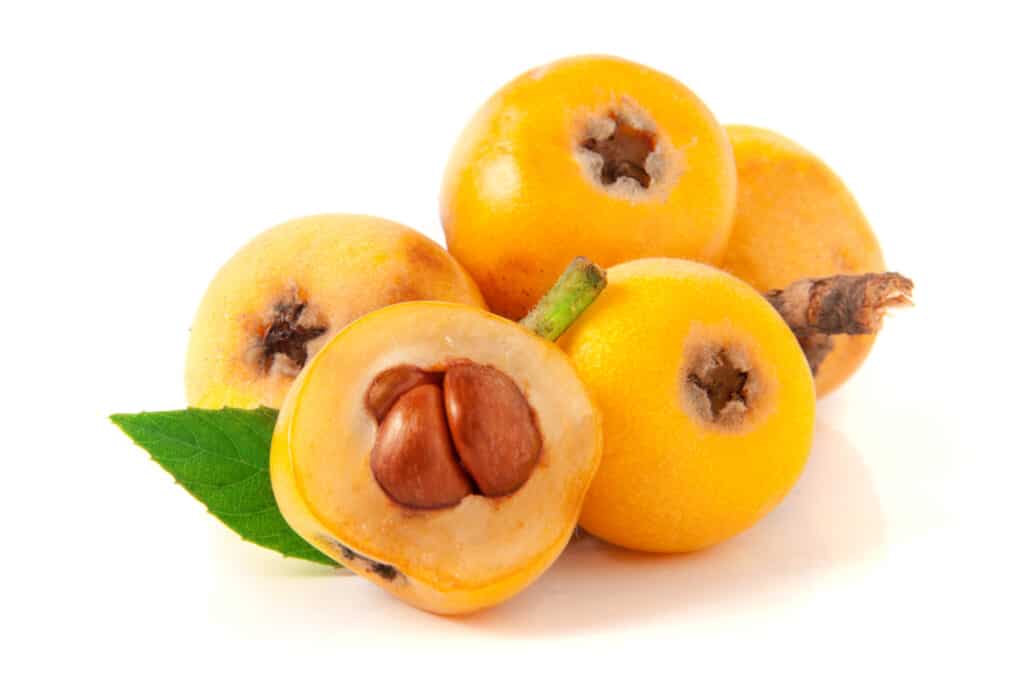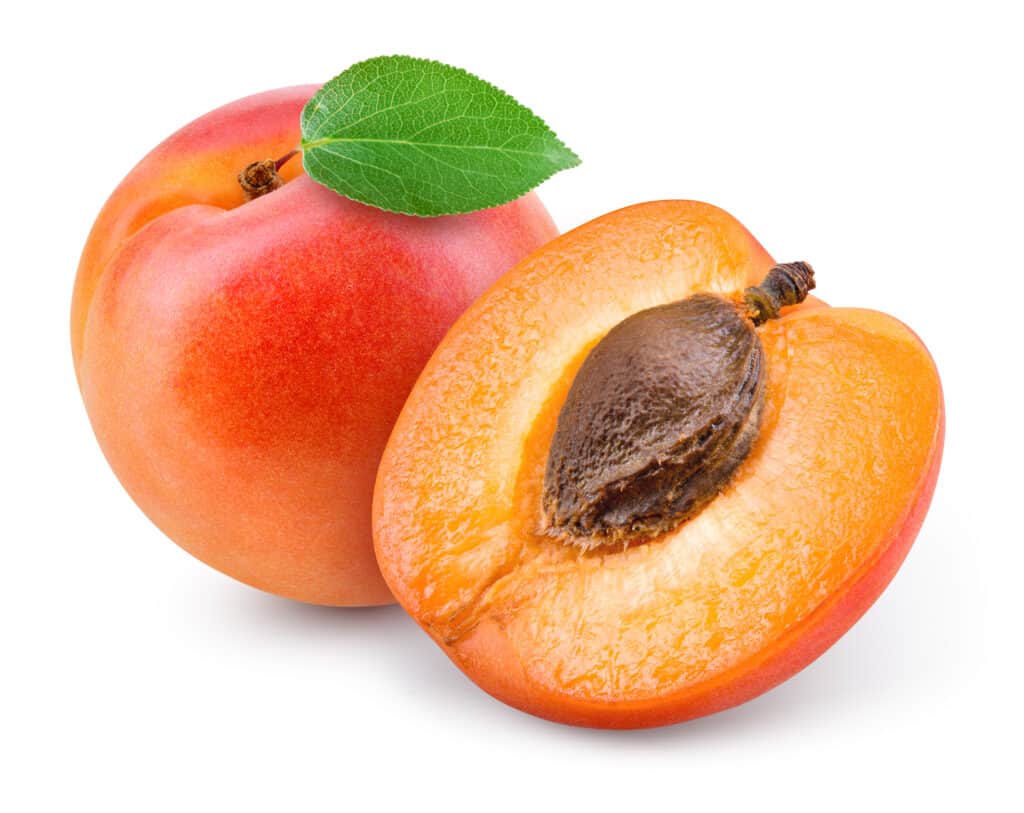Loquats and apricots look very similar. The fruit and the tree are hard to tell apart from each other. They are both members of the rose family and produce small round fruit. The fruit of both loquat and apricot is orange with sweet and tart flesh. However, there are a few differences between the two. They grow in different climates, fruit at different times of the year, and have different-looking seeds. We will break down all of the differences between the two in detail below, so let’s explore loquat vs. apricot!
Comparing Loquat vs. Apricot
| Characteristic | Loquat | Apricot |
|---|---|---|
| Scientific Name | Eriobotrya japonica | Prunus armeniaca |
| Common Names | Loquat. Japanese plum. Chinese plum. pipa. naspli. lukaat | Apricot. Briançon apricot. purple apricot. Japanese apricot |
| Origin | China | Central Asia and China |
| Tree Description | Evergreen shrub or tree. 16-33 feet high. Round crown, short trunk, wooly twigs | Deciduous tree. 26-39 feet high. Dense spreading canopy. |
| Leaf Description | Alternate leaves are 4-10 inches long. Dark green, leathery, serrated edges. velvety underside | Oval leaves, 2-3.5 inches long. pointy tip. serrated edges |
| Fruit Description | Orange fruit. Oval, round or pear-shaped. 1.5-2 inches in diameter. smooth downy skin that is orange or yellow. The flesh is whitish-yellow. Each fruit has 3-5 seeds. | Round fruit. .5-1 inch in diameter. smooth or velvety skin that is yellow or orange. The flesh is yellow. Each fruit has one seed. |
| Taste | Sweet and acidic. Floral with hints of peach | Sweet and tart |
| Growing | Flowers over winter and the fruit is ready to eat in April. USDA Zones 8+. Winter temperatures of 30°F or higher. Prefers elevations of 3000 feet or more | Flowers in early spring and the fruit is ready to eat in mid-June or July. USDA zones 5-8. Winter temperatures of -22°F or higher |
| Uses | Leaves for tea. Fruit is used fresh, pie, tart, salad, jam, and syrup. Ornamental tree | Fruit is used fresh, dry, frozen, salad, baked, and canned |
The Key Differences Between Loquats and Apricots

Loquats are small orange fruits with a sweet flavor.
©Nataly Studio/Shutterstock.com
The main differences between loquat and apricot are in the growing season. The two fruits also produce different types of seeds. Loquats are slightly bigger than apricots and have many seeds. Apricots are smaller and are considered stonefruit, with one large seed inside. Loquat and apricot are also used in different ways, which we will discuss below.
Loquat vs. Apricot: Name
The scientific name for loquat is Eriobotrya japonica. It is a member of the rose family, along with apples, pears, quinces, and plums. The loquat has many common names and is called something different in almost every country. You will hear the loquat called a Japanese plum, Chinese plum, pipa, naspli and lukaat, among many others.
The scientific name for apricot is Prunus armeniaca. It is also a member of the rose family, which is probably why the two trees share so many characteristics. The apricot is the opposite of the loquat in the common name department. It is called an apricot in almost every country. You will hear it called the Japanese apricot, Manchurian apricot, and Siberian apricot, among many others.
Loquat vs. Apricot: Tree Description
The loquat is an evergreen shrub or tree; it can keep its leaves because it grows in areas with mild winters. It grows to a mature height of 16 to 33 feet. Loquat trees have round crowns, short trunks, and wooly twigs. The leaves of the loquat tree are between four and ten inches long and grow in an alternate pattern. The leaves are dark green, leathery in texture, and have serrated edges. The underside of each leaf has a dense velvety hairy texture.
The apricot is a deciduous tree. It grows in colder climates than the loquat and loses its leaves each winter. It grows to a mature height of 26 to 39 feet. Apricot trees have a dense spreading canopy. The leaves of the apricot tree are between two and three and a half inches long. Each leaf is oval-shaped with a pointy tip and serrated margins.
Loquat vs. Apricot: Fruit Description and Taste

Apricots have velvety skin and contain only one large seed.
©Tim UR/Shutterstock.com
The loquat tree produces an orange fruit that is oval, round, or pear-shaped. Each fruit is between one and a half and two inches in diameter. Loquat fruits have smooth downy skin that is orange or yellow. The flesh is whitish-yellow and contains three to five seeds. Loquats have a sweet acidic taste—a pleasant floral flavor with a hint of peach.
The apricot tree produces a yellow or orange fruit that is round. Each fruit is between a half-inch to one inch in diameter. Apricot fruits have smooth, slightly velvety skin. The flesh is yellow and tastes sweet and tart. Apricots are stonefruit and contain one large seed.
Loquat vs. Apricot: Growing Requirements
The loquat is a unique tree because it forms flowers in late fall and early winter. The fruit forms over winter and is ready to eat in April when almost no other fruit is ripe. Loquats grow in many countries in the world. As long as the winter temperature is above 30°F, they are delighted. This range is a USDA Zone of 8 or higher in the USA. They prefer to grow at an elevation above 3000 feet in their natural environment.
Apricot trees form flowers in early spring, and the fruit is ready to eat in mid-June or July. Apricots are much more cold-hardy than loquats and can withstand winter temperatures as low as -22°F. This range is a USDA Zones 5 to 8.
Loquat vs. Apricot: Uses
People use Loquat leaves to make tea in many parts of the world. The fruit is delicious when eaten fresh. Bakers also use loquat fruits for pies and tarts. It is eaten in salads, jams, and syrups as well. Because of its unique wooly stems, it is often grown as an ornamental tree.
Apricots are eaten fresh and in salads. People preserve apricots by drying, freezing, and canning them. They are not the preferred choice for baked goods, but dried apricots are sometimes used in granolas, desserts, and parfaits.
Up Next
- Can Dogs Eat Apricots Safely? What Science Says. Before you head to the fruit market, be sure to check your choices for pet safety.
- 8 Houseplants That Grow in Water. Did you know that some plants will grow forever in water without soil?
- 10 Plants That Like Coffee Grounds. If you are looking for a free natural fertilizer, look no further.
The photo featured at the top of this post is © Nataly Studio/Shutterstock.com
Sources
- Gardening Know How, Available here: https://www.gardeningknowhow.com/edible/fruits/loquat/growing-loquat-fruit.htm
Thank you for reading! Have some feedback for us? Contact the AZ Animals editorial team.






